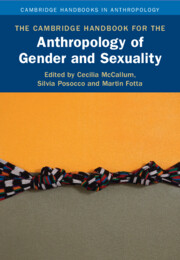Book contents
- The Cambridge Handbook for the Anthropology of Gender and Sexuality
- Cambridge Handbooks in Anthropology
- The Cambridge Handbook for the Anthropology of Gender and Sexuality
- Copyright page
- Contents
- Contributors
- 1 Introduction to The Cambridge Handbook for the Anthropology of Gender and Sexuality
- Part One Openings and Orientations
- Part Two Knowledges and Domains
- Part Three Resistances and Intersections
- Part Four Desires and Relations
- 18 Subjectivities, Knowledge, and Gendered and Sexual Transitions
- 19 Feminist and Queer Theories of the Non/Human and Paradoxical Possibilities of the Slash
- 20 Blood, Gender, and Politics in Indigenous View
- 21 “At Home” in Botox, Feminism, and Ethics
- Part Five Recursivities and Futures
- Name Index
- Subject Index
- References
18 - Subjectivities, Knowledge, and Gendered and Sexual Transitions
from Part Four - Desires and Relations
Published online by Cambridge University Press: 29 September 2023
- The Cambridge Handbook for the Anthropology of Gender and Sexuality
- Cambridge Handbooks in Anthropology
- The Cambridge Handbook for the Anthropology of Gender and Sexuality
- Copyright page
- Contents
- Contributors
- 1 Introduction to The Cambridge Handbook for the Anthropology of Gender and Sexuality
- Part One Openings and Orientations
- Part Two Knowledges and Domains
- Part Three Resistances and Intersections
- Part Four Desires and Relations
- 18 Subjectivities, Knowledge, and Gendered and Sexual Transitions
- 19 Feminist and Queer Theories of the Non/Human and Paradoxical Possibilities of the Slash
- 20 Blood, Gender, and Politics in Indigenous View
- 21 “At Home” in Botox, Feminism, and Ethics
- Part Five Recursivities and Futures
- Name Index
- Subject Index
- References
Summary
Based on ethnographic encounters in India over three decades, the authors reflect on what it means to study gender and the sexual. They argue that knowledge of gender and the sexual is bound up with epistemological and historical legacies, political ruptures, and subjective estrangements. In particular, the chapter critically engages the trajectories through which ontological assumptions about gendered and sexual selves have been configured and reconfigured over time. Moving away from the assumptions of “interiority” as the space for articulating or experiencing subjectivity, and from notions of “authentic,” extant cultural “types,” they look at the shifting material conditions and multiple temporal trajectories of forms of identification and self-evincing. Gendering and evincing of sexual selves emerge as terrains of partial connectedness between people, concepts, and material “things” as opposed to wholly defining attributes of any given subject. Three categories of gendered and sexual selves (kothi, hijra, and transgender) emerge and disappear over time in relation to each other, and to registers and economies of signification of law, health policy, activism, religious nationalism, and anthropology. This took shape within and across intimate lifeworlds, state actions, and transnational (mis)connections, here apprehended ethnographically.
- Type
- Chapter
- Information
- Publisher: Cambridge University PressPrint publication year: 2023



